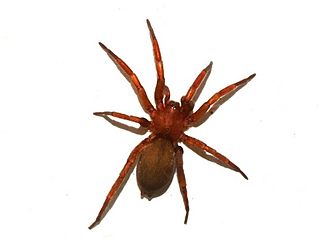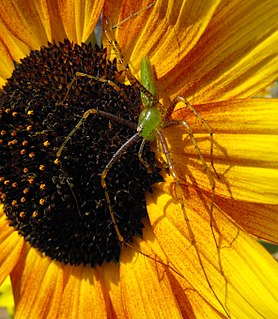
Minnetonka is a suburban city in Hennepin County, Minnesota, United States, eight miles (13 km) west of Minneapolis. The population was 49,734 at the 2010 census. The name comes from the Dakota Sioux mni tanka, meaning "great water". The city is the home of Cargill, the country's largest privately owned company, and UnitedHealth Group, the state's largest publicly owned company.

The Pholcidae are a family of araneomorph spiders. The family contains over 1,800 pholcids, including those commonly known as the marbled cellar spider , daddy long-legs spider, granddaddy long-legs spider, carpenter spider, daddy long-legger, vibrating spider, gyrating spider, long daddy, and skull spider. The family, first described by Carl Ludwig Koch in 1850, is divided into 94 genera.
Minnetonka High School, or MHS, is a four-year public high school located in Minnetonka, Minnesota, United States, a western suburb of Minneapolis-St. Paul. The school enrolls about 3,311 students, and offers four interchangeable academic curricula: International Baccalaureate, Advanced Placement, Honors, and G (general). Newsweek ranked the school at #123 in their list of America's Top High Schools. Minnetonka High School is rated #1 in public high schools in Minnesota by Niche.
Phrurolithidae is a family of araneomorph spiders first described by N. Banks in 1982. First included in the Corinnidae as the subfamily Phrurolithinae, later phylogenetic studies justified a separate family.
Scotinella dixiana is a species of phrurolithid spider first described in 1957 from specimens collected at Greensburg, Louisiana in 1936. They are small spiders, the females being under 1/10th inch in length. The females have a dark yellowish brown carapace with faint black radiating streaks and a narrow marginal black seam, and a dusky abdomen marked with a broad transverse band near the middle, two pale spots near the base and four narrow pale chevrons in the caudal half. The male's coloration is similar to that of the female, with a shining brown scutum marked by a single broad pale stripe near the middle. The species closely resembles Scotinella redemptus but is smaller. Some scientific classification schemes place the species in the family Corinnidae.
Enoplognatha marmorata, the marbled cobweb spider, is a species of cobweb spider in the family Theridiidae. It is found in North America.
Mastophora cornigera is a species of orb weaver in the spider family Araneidae. It is found in a range from the United States to Nicaragua. Like all known species of the genus Mastophora, adult females are bolas spiders, capturing their prey with one or more sticky drops at the end of a single line of silk rather than in a web. Males and juvenile females capture their prey directly with their legs.

Mastophora bisaccata is a species of orb weaver in the spider family Araneidae. It is found in the United States and Mexico. Like all known species of the genus Mastophora, adult females are bolas spiders, capturing their prey with one or more sticky drops at the end of a single line of silk rather than in a web. Males and juvenile females capture their prey directly with their legs.

Haplodrassus signifer is a species of ground spider in the family Gnaphosidae. It is found in North America, Europe, Turkey, Israel, Caucasus, a range from Russia to Central Asia, China, and Korea.

Peucetia longipalpis is a species of lynx spider in the family Oxyopidae. It is found in a range from the United States to Venezuela.It was first described by Frederick Octavius Picard-Cambridge in the year 1902.
Clubiona riparia, the riparian sac spider, is a species of sac spider in the family Clubionidae. It is found in Russia, Mongolia, China, Japan, and North America.
Socalchemmis idyllwild is a species of false wolf spiders & wandering spiders in the family Zoropsidae. It is found in the United States.
Scotinella is a genus of North American araneomorph spiders in the family Phrurolithidae, first described by Nathan Banks in 1911.

Hypsosinga pygmaea is a species of orb weaver in the spider family Araneidae. It is found in North America, Europe, Turkey, Israel, Caucasus, a range from Russia to Central Asia, China, Korea, and Japan.
Scotinella sculleni is a species of true spider in the family Phrurolithidae. It is found in the United States and Canada.
Tibellus duttoni is a species of running crab spider in the family Philodromidae. It is found in the United States and Mexico.
Stenacron minnetonka is a species of flatheaded mayfly in the family Heptageniidae. It is found in North America.
Scotinella redempta is a species of true spider in the family Phrurolithidae. It is found in the United States and Canada.
Scotinella fratrella is a species of true spider in the family Phrurolithidae. It is found in the United States and Canada.





